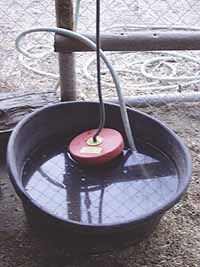The culinary water systems throughout the United States are considered safe by the majority of Americans. And for the most part, the systems are.
However, compromises in by consumers connecting to the systems can result in unsafe water ending up in drinking glasses due to a problem called “cross connections.”
When Carbon County residents think about unsafe drinking water, they think about open steams or springs. They think about what happens when disasters like floods or earthquakes occur and water systems are compromised. They think about avoiding to drink the water in a foreign country.
But poor quality can happen in anyone’s home attached to a public culinary system if a cross connection between non-potable water and the clean line takes place.
And it can happen easier than most people believe.
The common misconception is that a cross connection between two sources only occurs when pipes are joined that contain different types of water, whether it be a secondary system directly connected to culinary plumbing or a sewer connection hooked up incorrectly.
People create the potential for such problems almost daily on every water system in the country. All it takes is a hose left in a kiddie pool or animal watering dish and the potential for cross contamination occurs.
Generally, water systems are continually intact and under pressure.
But should the pressure be interrupted for any reason – such as a break in the line or a construction project that requires the temporary discontinuation of service – hoses left in polluted sources of liquid can act as siphons and pull contaminates into the home’s culinary supply or the main line.
Each year, dozens of back flow problems occur in the state of Utah.
One example is trying to clean a sewer with a garden hose and leaving it in the line. A second example is a sprinkling system that shuts off in the middle of the cycle because the pressure fails. A submerged sprinkler head can draw water back into the house’s culinary system, pulling in pesticides and organic matter that contaminates the lines.
In some cases, toxic chemicals have even been drawn into shut down lines and caused illness as well as death.
The public water system in Utah is protected by law and codes. The Utah Plumbing Code prohibits the connection between unclean water or liquid supplies and a culinary system.
Where the connections are necessary, a backflow preventer must be installed to prevent the problem. A preventer basically provides a physical break or an air pocket in the system to keep siphoning from happening.
Examples are boiler systems in large buildings and systems that use toxic chemicals as water conditioners.
In the case of private residences, the most common occurrence happens with hose or sprinkler systems.
Many newer homes have vacuum breakers installed to prevent backflow from outside sources, while most older dwellings do not.
However, it is best not to count on the devices, particularly if systems like lawn sprinklers were not installed by a licensed plumbing or contractor. Often, water companies install back flow preventers on the meters at the street.
In private residences, there are a number of ways water systems can be compromised.
People frequently attach hoses to a sink to fill buckets or do other kinds of work. Hoses should be kept out of any sink or container that could contain contaminated liquids.
The rule should be followed for all types of sinks, including kitchen faucets with sprayers and laundry equipment.
If a sink is used for developing photographs, a vacuum breaker backflow device must be installed.
Toilets are another area of possible contamination. Once water is drawn into the toilet tank, it should be stopped from flowing back into the culinary system.
Toilet tanks often contain chemicals from the time release coloring or disinfecting agents used by residents. Every toilet should have an anti-siphon ballcock assembly in its tank.
Another area of concern involves the bathtub. In most cases, an air gap exists between the tub and the faucet. However, when a hose is connected for a hand-held shower, it can be placed in water that may remain in the tub and become a source of contaminants.
When a hand-held shower is used, a hose vacuum breaker needs to be attached.
Washing machines are generally not a problem because the appliances have a built in air gap. When the water gets shut off, the devices keep the backflow from happening.
Outside hose bibs that do not have a backflow preventer can easily be adapted with a hose bib vacuum breaker. The device is inexpensive and connects directly to the threaded hydrant.
For water conditioners, an air gap must be present to keep backflow from occurring. The preventative device can be provided by using an air gap.
The average private resident seldom considers the ramifications of backflow occurring within a home. But the situation occurs more often than people think. Backflow can be a big problem that can be solved with a little thought beforehand.
Exercise caution to curb backflow contamination

